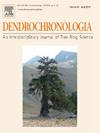干旱限制了小高加索地区两种重要的生态和经济树种的生长和水力能力
IF 2.7
3区 农林科学
Q1 FORESTRY
引用次数: 0
摘要
预计全球气候变化将强烈影响亚美尼亚山区森林的生物多样性森林生态系统。目前尚不清楚气候变化,特别是极端干旱事件是如何影响两种重要的生态和经济树种——橡树的。,答:好的。山毛榉(Fagus orientalis Lipsky)。然而,这对于设计合适的管理实践和指导未来的恢复工作至关重要。本文基于1950 - 2011年的树木年轮和船舶相关参数,研究了亚美尼亚东北部塔武什省14棵橡树和22棵山毛榉的总体气候敏感性和对极端气候事件的响应。我们发现干旱条件主要限制了春季橡树的生长,而夏季水分供应对山毛榉的生长最为重要,这与它们的木材解剖特征是一致的。在研究期间,这两个物种的气候-生长关系都不稳定,并且表明在过去几十年中,生长对水分供应的敏感性不断增加。这种趋势在山毛榉中比在橡树中更为明显。在极端干旱年份,两种植物的年生长量和水导率均显著降低,但在随后的2年内出现恢复。我们发现,这两个物种都能忍受极端干旱条件,因此应该考虑在未来的重新造林工作中加以考虑。然而,随着未来干旱的时间、频率和强度预计将发生变化,需要对这两种重要树种进行进一步的评估和监测。本文章由计算机程序翻译,如有差异,请以英文原文为准。
Drought limits growth and hydraulic capacity of two ecologically and economically important tree species in the Lesser Caucasus
Global climate change is expected to strongly impact the biodiverse forest ecosystems in the mountain forests of Armenia. It is still uncertain how climate variability and especially extreme drought events affect the two ecologically and economically important tree species, oak (Quercus macranthera Fisch. & C. A. Mey. ex Hohen) and beech (Fagus orientalis Lipsky). However, this is crucial for designing suitable management practices and guiding future restoration efforts. Here, we investigated the overall climate sensitivity and response to extreme climate events of 14 oak and 22 beech trees from the Tavush province, north-eastern Armenia, based on tree-ring and vessel-related parameters for the period 1950 – 2011. We found that drought conditions mostly limit oak growth during spring, while water availability during summer is most important to beech growth, which is consistent with their wood anatomical characteristics. Climate-growth relationships for both species were not stable over the investigated period and indicated increasing growth sensitivity to water availability in the last decades. This trend was more pronounced for beech than for oak. During extreme dry years, annual growth increment and hydraulic conductivity of both species were significantly reduced but appeared to recover within the following two years. We found that both species can tolerate extreme drought conditions and should therefore be considered for future reforestation efforts. However, as the timing, frequency and intensity of droughts are expected to change in the future, further assessment and monitoring of these two important tree species is needed.
求助全文
通过发布文献求助,成功后即可免费获取论文全文。
去求助
来源期刊

Dendrochronologia
FORESTRY-GEOGRAPHY, PHYSICAL
CiteScore
5.50
自引率
13.30%
发文量
82
审稿时长
22.8 weeks
期刊介绍:
Dendrochronologia is a peer-reviewed international scholarly journal that presents high-quality research related to growth rings of woody plants, i.e., trees and shrubs, and the application of tree-ring studies.
The areas covered by the journal include, but are not limited to:
Archaeology
Botany
Climatology
Ecology
Forestry
Geology
Hydrology
Original research articles, reviews, communications, technical notes and personal notes are considered for publication.
 求助内容:
求助内容: 应助结果提醒方式:
应助结果提醒方式:


